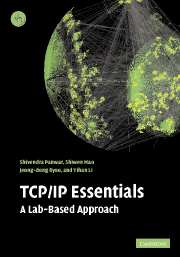Book contents
- Frontmatter
- Contents
- Preface
- Acknowledgements
- General conventions
- List of abbreviations
- 0 TCP/IP overview
- 1 Linux and TCP/IP networking
- 2 A single segment network
- 3 Bridges, LANs and the Cisco IOS
- 4 Static and dynamic routing
- 5 UDP and its applications
- 6 TCP study
- 7 Multicast and realtime service
- 8 The Web, DHCP, NTP and NAT
- 9 Network management and security
- References and further reading
- Appendix A Instructor's guide
- Appendix B Initial configuration of the routers
- Appendix C Source code
- Appendix D List of key requests for comments (RFC)
- Index
3 - Bridges, LANs and the Cisco IOS
Published online by Cambridge University Press: 05 June 2012
- Frontmatter
- Contents
- Preface
- Acknowledgements
- General conventions
- List of abbreviations
- 0 TCP/IP overview
- 1 Linux and TCP/IP networking
- 2 A single segment network
- 3 Bridges, LANs and the Cisco IOS
- 4 Static and dynamic routing
- 5 UDP and its applications
- 6 TCP study
- 7 Multicast and realtime service
- 8 The Web, DHCP, NTP and NAT
- 9 Network management and security
- References and further reading
- Appendix A Instructor's guide
- Appendix B Initial configuration of the routers
- Appendix C Source code
- Appendix D List of key requests for comments (RFC)
- Index
Summary
Algorhyme
I think that I shall never see
A graph more lovely than a tree.
A tree whose crucial property
Is loop-free connectivity.
A tree that must be sure to span
So packets can reach every LAN.
First, the root must be selected.
By ID, it is elected.
Least-cost paths from root are traced.
In the tree, these paths are placed.
A mesh is made by folks like me,
Then bridges find a spanning tree.
Radia PerlmanObjectives
The Cisco Internet Operating System software.
Configuring a Cisco router.
Transparent bridge configuration and operation.
The spanning tree algorithm.
Ethernet bridges
Use of bridges
Bridges are link layer devices. As illustrated in Fig. 0.3, when two network segments with different link and physical layer protocols are connected, the bridge performs a two-way translation of the protocols. The data section of a transit frame is extracted and re-encapsulated in the frame format used by the next-hop network segment.
However, there are several reasons to use bridges to connect networks even with identical protocols, rather than using a large network without bridges. First, network segments could be far away from each other but still work within the same logical network. In this case, two remote network segments can be linked by two bridges via a point-to-point wide area link. Second, there is a limit on the maximum length of the shared medium in a local network.
- Type
- Chapter
- Information
- TCP/IP EssentialsA Lab-Based Approach, pp. 61 - 76Publisher: Cambridge University PressPrint publication year: 2004

